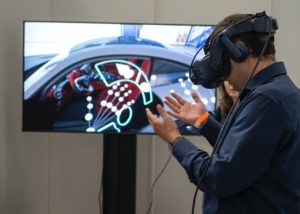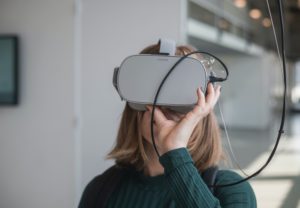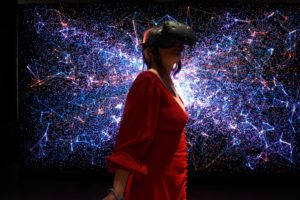Digitisation of the workplace is transforming the business landscape.
Currently, 38% of organisations are implementing technology and investing in their digital workspaces. The motivation behind this wave of innovation is twofold. Digital transformation will have both organisational and individual impact.
Not only does a digital workspace allow smaller enterprises to keep pace with larger corporates, but it also enables a wider candidate talent pool and has been shown to greatly improve business revenue. In addition, research has suggested that a digital workplace increases employee productivity by as much as 33%.

Remote working and tech.
One of the more welcome changes though has been the way we work and where we do it. An army of remote employees has sprung up; some out of necessity and some from choice. This version of events looks as though it’s here to stay, and we rely on technology to make this possible.
One of these technologies is Augmented Reality. This immersive technology drowns you in a completely digitised platform. AR glasses enhance reality using the power of digital layering. The wearer can interact with the digital layers in front of them, taking their own surroundings and adding a productivity layer to the workplace structure. For example, AR can display vast amounts of data before your eyes, place a wearer in a virtual meeting or assist in the interview process.
Tech giants are all in on the race to produce the most popular AR goggle design. Apple and Microsoft are just two of the names hoping to top the podium.

AR and VR alike have the potential to revolutionise the working world. So far, it has yet been untapped, but the tables are turning. Over the last decade, these technologies have been slowly making their way into the corporate world and now it looks set to boom.
There are also concerns that remote working could stall tech career progression. As we’ll see, by using AR and VR, these worries surrounding training and colleague connection could be abated.
How are AR and VR changing the workplace?
Here are 5 ways in which AR and VR are transforming the working scene. If you are a business leader, you’d do worse than consider investing in AR and VR solutions for your workplace.
Improved Communication.
One of the greatest benefits of AR and VR is the way it enables us to improve communication with our colleagues. Remote working has very readily become the standard for many of us. Indeed, 23% of corporate companies plan to stay remote for the next 5 years.
While this has been welcomed, it makes organic communication a challenge.
AR and VR have the power to enhance digital communication through their immersive properties. Using Augmented Reality and VR headsets, remote workers can join meetings virtually and see the 3D faces of their colleagues in real-time. Something that is critical in place of true human interaction.
AR also aids 1-1 discussions between colleagues or teams. Headsets also allow more productive conversations. Data can be shared in a real-time setting for maximum output and productivity.

Training.
AR can immerse developing staff in real-world scenarios. It has the power to revolutionise staff training. Using AR, we can experience workplace training from the comfort of our home office.
Mock activities and enhanced remote learning are both ways in which AR can improve learning opportunities for new starters and those who wish to develop existing skills.
For companies, training using AR technologies has the power to reduce business costs. Training a team in this way improves the speed and depth of training. It also lessens the need for staff assistance, meaning that the production value of existing teams can remain high.

The interview and onboarding process.
Over the next 5 years, AR also has the potential to transform the hiring and onboarding process. New or potential candidates have the option of virtually shadowing a colleague, meeting their new team “in-person”, or getting a feel of organisational culture through an augmented office walkabout.
This throws the candidate into the practicalities of the job they’ll be doing. It also gives employers an edge during gives the new remote interview process that we have all had to adopt in this mid/post covid world. Remote interviews are often sterile experiences and occasionally, candidates have reported a lack of “connection”.
Digital solutions that can help remedy this should be welcomed by employers looking to stand out within a competitive market.
Immersive connection and digital care.
Remote workers are more likely to experience their own version of ‘long covid’. Indeed mental health charities have reported a pandemic of their own.
Cases of anxiety, loneliness, and depression have hit record highs over the duration of the pandemic. For remote workers, swapping the everyday office chatter for a singular screen has only increased feelings of isolation for many.
Workers are coming to rely on AR to forge and retain a connection. Companies are using AR and VR to enable digital workshops, to aid loneliness and the work-related stresses experienced by remote workers. Using AR and VR to facilitate employee mental health discussions vastly improves worker morale and general productivity levels. A productive, content, and connected workforce are all vital for business success.

Organising data.
One of the most transformative uses of AR and VR technologies in the workplace is its ability to improve data organisation and visualisation, for both stakeholders and employees.
Using AR eyewear, large streams of data can be viewed in real-time. This makes data findings tangible, makes it easier to plan projects and research or develop strategies.
Presentations to stakeholders can be offered in a visual format using AR and VR. Proposals instantly become more engaging and a targeted visual experience. Ideas and proposals take on their own identity, allowing theory to be seen in a more realistic and visual format. Concepts and ideas become exciting. If you’re asking for budget or investment, this can only be a good thing!

The future of AR and VR in the workplace.
The post-pandemic corporate world is facing significant challenges. Businesses have been forced to pivot and adapt to an evolving landscape amid changes in customer demand. During uncertain and turbulent times, it’s undeniable that it’s been technology and digital tools that have enabled many sectors to keep the wheels turning.
Technological advances are hitting the market all the time. Indeed, technology has been one sector that has thrived amid a pandemic that has brought many sectors to their knees.
One such advance is AR. As we have seen, it has the power to dramatically enhance the world of work, for both companies and those who work within them. In particular, the army of remote workers looks set to benefit from the implementation of AR and VR tech.
From communication, connectivity, and onboarding, AR and VR have the power to transform the experience of remote workers everywhere.
Do you use AR and VR in your workplace? Have you found it to be useful, or one tech step too far?
Let us know in the comments section below. We’d love to hear what you have to say!





